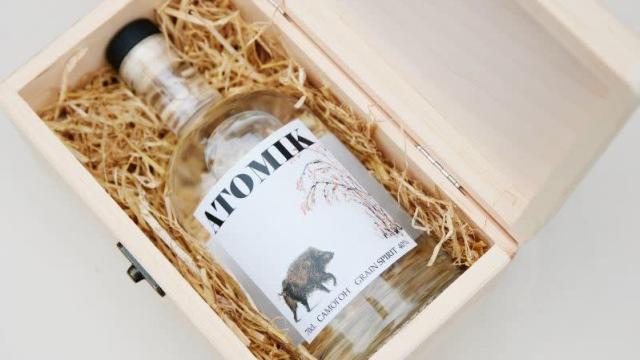Grains and water from Chernobyl’s dreaded exclusion zone have been used to produce a single bottle of vodka. Called ATOMIK, the vodka could revolutionise the way land is reclaimed in the radioactive region surrounding the beleaguered nuclear power plant.
A collaboration involving scientists from the UK and Ukraine has produced radioactive-free vodka from crops grown in the Chernobyl Exclusion Zone, according to a University of Portsmouth press release.
Described as “high quality artisan vodka,” the alcoholic beverage was brewed by the Chernobyl Spirit Company, and branded — appropriately enough — ATOMIK. Only one bottle of ATOMIK currently exists, and the product is not yet for sale, but it’s considered the first commercial product to come from the exclusion zone, the BBC reports. Jim Smith, a professor of environmental science at the University of Portsmouth, led the project.
Part science, part promotional stunt, the project is meant to demonstrate a possible way in which land in and around the damaged nuclear power plant can be put to good use, namely through the growing of crops. The producers of this single bottle of vodka are hoping it could lead to something far grander — the revitalisation of a traditional Ukrainian industry in a region beset by economic distress.
“More than thirty years after the accident, we believe that what these areas need most is economic development and management of the unique wildlife resource the abandoned areas represent,” declares the Chernobyl Spirit Company’s website.
To that end, at least 75 per cent of profits from future sales of ATOMIK will go to supporting local communities in affected areas and to wildlife conservation. This vodka won’t solve all the region’s problems, obviously, but it might provide a needed boost to the recovery process.
Established after the 1986 Chernobyl nuclear accident, the exclusion zone encompasses an area measuring 2600 square kilometres. Around 116,000 people fled the area immediately after the plant exploded, followed by another 220,000 people who had to be resettled. The total area of evacuation stretched across a region measuring 4200 square kilometres.
Access to the exclusion zone is limited to protect human health and to prevent the ongoing spread of radioactive materials. Use of the land for agriculture is strictly forbidden by the Ukrainian government — something Smith and his collaborators would like to change. Along with colleagues in the UK and Ukraine, Smith has spent the last three years assessing the radioactive potential of crops grown in the outer band of the exclusion zone.
“We don’t think the main Exclusion Zone should be extensively used for agriculture as it is now a wildlife reserve,” said Smith in the press release. “But there are other areas where people live, but agriculture is still banned.”
Because areas within the zone are not equal in terms of radiation risk, it has been subdivided into three parts. Zone I, known as the main zone, exists within a 10 kilometre radius of the damaged nuclear power plant — a high danger zone in which virtually all activities are prohibited. A buffer zone, called Zone II, and the semi-functional Zone III are situated between 10 and 30 kilometres of the plant, within which various activities are permissible, including controlled public access (the area is popular with tourists, for example).
The town of Chernobyl is located 15 kilometres south of the plant, and it’s the temporary home for shift workers who use the city’s hostels and hotels, administrative buildings, restaurants, medical facilities, and cultural centres (many of the workers are involved with the ongoing decommissioning of the plant, which is expected to last until the 2060s). Thousands of citizens inhabit the immediate area in and around the exclusion zone, according to the University of Portsmouth press release.
To create the ATOMIK vodka, Smith and his colleagues sourced grain and water from within the exclusion zone. Tests showed that the grain was slightly radioactive. The amounts of strontium-90 were just a smidge above the Ukrainian safety limit of 20 Bq/kg. That’s not considered safe enough to bake bread, but it’s a different story when it comes to making distilled beverages, as the distilling process removes all impurities from the grains.
Tests of the vodka showed that ATOMIK was perfectly safe to drink (well, at least as “safe” as any alcoholic beverage), with levels of radiation no different than ordinary alcoholic beverages.
Mineral water for the project was sourced from a deep aquifer in the town of Chernobyl, which was used to dilute the distilled alcohol. Tests of this water showed that it was free from radioactive contamination, and similar in chemistry to groundwater sourced from the Champagne region of France.
“Thirty-three years on, many abandoned areas could now be used to grow crops safely without the need for distillation,” said Smith in the release. “We aim to make a high-value product to support economic development of areas outside the main Exclusion Zone where radiation isn’t now a significant health risk.”
Oleg Nasvit, the first deputy head of Ukraine’s state agency for exclusion zone management, said his office welcomes the “initiative to use abandoned lands to help local communities,” and that it’s “important that we do everything we can to support the restoration of normal life in these areas whilst always putting safety first,” he said in the release.
As to how the vodka tasted, Nasvit said, “I’d call this a high quality moonshine — it isn’t typical of a more highly purified vodka, but has the flavour of the grain from our original Ukrainian distillation methods — I like it.”
In terms of next steps, Smith and his colleagues say they need to sort out some unspecified legal issues, followed by small-scale experimental production of the ATOMIK vodka, which they hope to complete by later this year.
